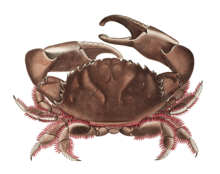
The Bering Sea is a marginal sea of the Northern Pacific Ocean. It forms, along with the Bering Strait, the divide between the two largest landmasses on Earth: Eurasia and the Americas. It comprises a deep water basin, which then rises through a narrow slope into the shallower water above the continental shelves. The Bering Sea is named after Vitus Bering, a Danish-born Russian navigator, who, in 1728, was the first European to systematically explore it, sailing from the Pacific Ocean northward to the Arctic Ocean.

Leyte Gulf, also known simply as the Leyte, is a gulf in the Eastern Visayan region in the Philippines. The bay is part of the Philippine Sea of the Pacific Ocean, and is bounded by two islands; Samar in the north and Leyte in the west. On the south of the bay is Mindanao Island, separated from Leyte by the Surigao Strait. Dinagat Island partly encloses the gulf to the southeast, and the small Homonhon Island and Suluan Island, sit astride the eastern entrance to the Gulf. It is approximately 130 km (81 mi) north-south, and 60 km (37 mi) east-west.

The Caribbean hermit crab, also known as the soldier crab, West Atlantic crab, tree crab, or purple pincher, is a species of land hermit crab native to the west Atlantic, Belize, southern Florida, Venezuela, and the West Indies.

The Japanese spider crab is a species of marine crab and is the biggest one that lives in the waters around Japan. At around 3.7 meters, it has the largest leg-span of any arthropod. The Japanese name for this species is taka-ashi-gani,, literally translating to “tall legs crab”. It goes through three main larval stages along with a prezoeal stage to grow to its great size.

The halloween hermit crab, also known as the striped hermit crab or orange-legged hermit crab, is a brightly colored aquatic hermit crab of the family Diogenidae. Besides its ability to routinely clean algae in aquaria, the halloween hermit crab's festive striped coloration also appeals to enthusiasts; it is considered the most brightly colored hermit crab in normal aquarium use.
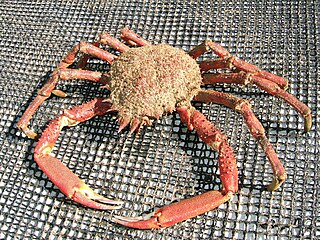
Maja squinado is a species of migratory crab found in the Mediterranean Sea. The appearance of the European spider crab is similar to the much larger Japanese spider crab, although the European spider crab belongs to the family Majidae, and the Japanese spider crab belongs to a different family of crabs, the Macrocheiridae.

Macrophthalmus is a genus of crabs which are widespread across the Indo-Pacific. It contains the following species : Species in this genus are often referred to as sentinel crabs.

Hemigrapsus sanguineus, the Japanese shore crab or Asian shore crab, is a species of crab from East Asia. It has been introduced to several other regions, and is now an invasive species in North America and Europe. It was introduced to these regions by ships from Asia emptying their ballast tanks in coastal waters.
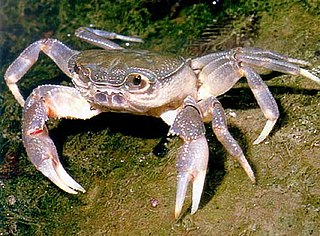
Potamon is a genus of freshwater or semiterrestrial crabs mainly found from Southern Europe through the Middle East, and as far east as north-western India. The only exception is the North African P. algeriense, which also is the only potamid of mainland Africa. Twenty species are currently recognised. These crabs are omnivores that have a broad ecological tolerance. The adult Potaman reach up to 50 mm in size during their 10-12 year life span.
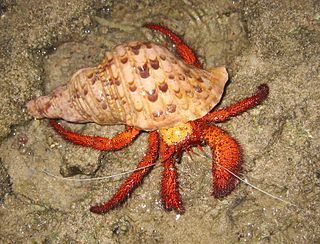
Dardanus megistos, the white-spotted hermit crab or spotted hermit crab, is a species of hermit crab belonging to the family Diogenidae.

Etisus is a genus of crabs, containing the following extant species:

Atergatis is a genus of crabs in the family Xanthidae, containing the following species:

Around 65 species of crab occur in the waters of the British Isles. All are marine, with the exception of the introduced Chinese mitten crab, Eriocheir sinensis, which occurs in fresh and brackish water. They range in size from the deep-water species Paromola cuvieri, which can reach a claw span of 1.2 metres, to the pea crab, which is only 4 mm (0.16 in) wide and lives inside mussel shells.

Dorippe frascone, the urchin crab or carrier crab, is a small species of crab in the family Dorippidae that was first described scientifically by J.F.W. Herbst, in 1785. It is found in the Red Sea and parts of the western and eastern Indian Ocean. It often has a symbiotic relationship with a long-spined sea urchin and carries one around on its carapace.
E. dentatus may refer to:

Charybdis natator, the ridged swimming crab, wrinkled swimming crab or rock crab, is a widespread Indo-Pacific species of swimming crab from the genus Charybdis. It gets its name from the ridges on the dorsal surface of the carapace. It is a crab species which is of minor importance in fisheries.
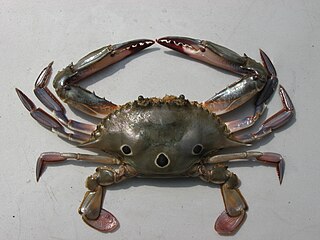
Portunus sanguinolentus, the three-spot swimming crab, blood-spotted swimming crab or red-spotted swimming crab, is a large crab found throughout estuaries of the Indian and West Pacific Oceanic countries.

The Ōshima Strait is a strait between the islands of Amami Ōshima and Kakeromajima in Japan. It is part of the Amami Guntō National Park. From the western most side to the eastern most side of the strait, the strait measures 17.5 miles (28.2 km) long.

Hepatus pudibundus, the flecked box crab, is a crab from the class Malacostraca. They are found in the Atlantic Ocean with Brazil having a dense population of H. pudibundus, as they are one of the most commonly seen crabs in the country. Many of the studies done on H. pudibubus have occurred in the Ubatuba region of Brazil, where there is a rapid expansion of tourism that is affecting marine ecosystems.
